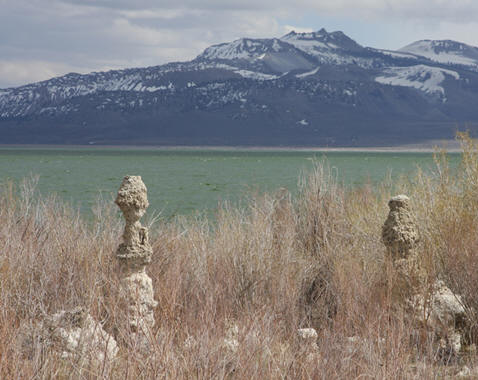January 2003 Notes on Meromixis
From Bob Jellison, UCSB Researcher
 Although we thought the lake was going to turn over
this winter, the early December storms resulted in enough inputs of
fresh water to the upper layer that turnover was prevented. The lake
did however mix completely down to ~28 m and in so doing entrained
water with high concentrations of ammonium. Thus the very high algal
concentrations. While it of course depends on the runoff, the most
likely scenario is that the lake will turn over next fall. As the lake
has mixed deeper each of the last three years and only a small volume
is beneath the chemocline, it will likely be less noticeable than in
1988.
Although we thought the lake was going to turn over
this winter, the early December storms resulted in enough inputs of
fresh water to the upper layer that turnover was prevented. The lake
did however mix completely down to ~28 m and in so doing entrained
water with high concentrations of ammonium. Thus the very high algal
concentrations. While it of course depends on the runoff, the most
likely scenario is that the lake will turn over next fall. As the lake
has mixed deeper each of the last three years and only a small volume
is beneath the chemocline, it will likely be less noticeable than in
1988.
September 2002 Notes on Meromixis
From Bob Jellison, UCSB Researcher
The secchi depths, a measure of transparency and algal abundance, were about 2 m on September 17 and the Artemia while declining markedly are still quite abundant. We won’t have exact numbers for comparison to other years until the samples are counted. The Secchi is unusually low (phytoplankton abundant) for September and reflects the breakdown of meromixis and increased nutrient fluxes upward from the bottom where they have been accumulating the past eight years. Secchi depths have only been this low in September one other year and that was 1988 when the previous 6-yr period of meromixis broke down. We projected the evaporative concentration of the surface water observed thus far this summer to December 1st and the lake will be very close to turning over this year. If it does not turn over this winter, it certainly will next year. Even if it does not completely mix this year, we can expect next year to have very high levels of primary productivity as nutrient concentrations increase throughout the water column due to the entrainment of nutrient-rich monimolimnetic water.
Background information on meromixis
